YouTube has transformed from a simple video-sharing platform into a powerful ecosystem where content creators can build careers and generate substantial income. Today’s YouTubers are self-made entrepreneurs, captivating audiences with entertaining, educational, and engaging content. If you’re looking to monetize your YouTube channel, numerous strategies can help you turn views into revenue.
This guide, brought to you by money-central.com, your trusted source for financial expertise, explores effective methods for How To Make Money From Youtube. We’ll delve into diverse approaches, from leveraging YouTube’s built-in monetization features to exploring external avenues, providing a comprehensive roadmap to YouTube monetization success.
Understanding the YouTube Partner Program: Your First Step to Monetization
The YouTube Partner Program (YPP) is the cornerstone of monetization for most creators. Joining the YPP unlocks access to various revenue streams directly within YouTube, allowing you to earn from your content across different formats, including Shorts, livestreams, and long-form videos.
As a YPP member, you gain access to:
- Ad Revenue Sharing: Earn a portion of the revenue generated from ads displayed on your videos and between Shorts.
- YouTube Premium Revenue: Receive a share of revenue from YouTube Premium subscribers who watch your content.
- Fan Funding Features: Utilize Super Chat, Super Thanks, and channel memberships to allow your audience to directly support your channel financially.
- YouTube Shopping: Showcase and sell products to your audience directly from your YouTube channel.
Beyond monetization, the YPP provides valuable resources like YouTube’s creator support and the Copyright Match tool to protect your original content and navigate the platform effectively.
While the YPP is a significant pathway to monetization, it’s not the only option, and it may not always be the most profitable depending on your channel and audience. Exploring avenues like external stores, affiliate partnerships, and sponsored content can complement or even surpass ad revenue. However, the YPP membership often simplifies or enables many of these monetization methods.
With YouTube having paid out over $50 billion to YPP members in the last three years, joining the program is a crucial first step if you meet the eligibility criteria.
Eligibility for the YouTube Partner Program
To qualify for the YouTube Partner Program and unlock its monetization features, your channel must meet specific requirements:
- Subscriber Count: Achieve a minimum of 1,000 subscribers.
- Watch Hours or Shorts Views: Accumulate either 4,000 valid public watch hours in the past 12 months or 10 million valid public Shorts views in the last 90 days.
It’s important to note that some program features may become accessible even before reaching these full eligibility thresholds.
Furthermore, your channel needs to be in good standing with YouTube’s community guidelines and adhere to all YouTube’s monetization policies. You must also reside in an eligible region to participate.
Once you meet these criteria, applying is straightforward. Navigate to YouTube Studio, access your channel dashboard, and find the “Earn” tab to begin the application process.
1. Maximizing Ad Revenue on YouTube Videos
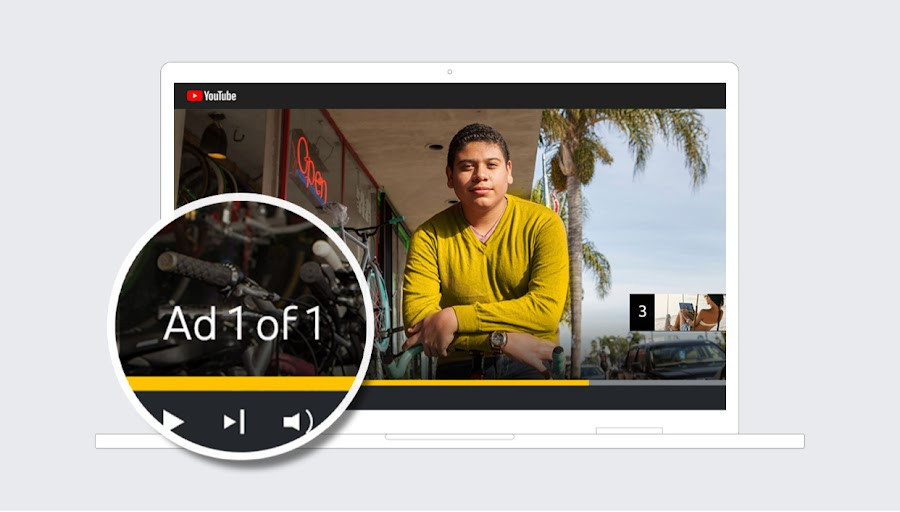 Example of a YouTube video with in-video advertisement for bicycle brand
Example of a YouTube video with in-video advertisement for bicycle brand
Once accepted into the YouTube Partner Program, the most direct way to start generating income is by enabling ads on your videos. YouTube’s advertising platform is largely automated, streamlining the process for creators.
When you enable monetization for a long-form video, YouTube automatically inserts a combination of pre-roll (before the video starts) and post-roll (after the video ends) ads. These ads may be skippable or non-skippable. While you don’t have direct control over the specific ads shown, for videos exceeding eight minutes in length, you gain the option to strategically place mid-roll ads within the video itself. Mid-roll ads can be inserted automatically by YouTube or manually positioned by you for optimal placement.
To monitor your ad earnings, navigate to the “Revenue” tab within YouTube Studio. This section provides detailed reports on your ad revenue performance, including estimated monthly earnings for videos with monetization enabled.
Exploring Revenue Beyond YouTube Ads
While YouTube ad revenue offers a relatively simple and passive income stream, relying solely on ads may not yield substantial earnings, especially for smaller or newer channels. To maximize your YouTube income, consider diversifying your monetization strategies.
YouTube’s demonetization policy can sometimes be perceived as strict by creators. Certain content may be flagged as not advertiser-friendly, limiting or eliminating ad revenue potential. Additionally, YouTube retains a significant portion of ad revenue: 45% for standard videos and 55% for Shorts. This revenue share underscores the importance of exploring alternative and supplementary income streams to build a sustainable YouTube business.
2. Engaging Your Audience with Fan Funding
 Patreon page example of Wait But Why YouTube channel demonstrating fan funding model
Patreon page example of Wait But Why YouTube channel demonstrating fan funding model
For creators within the Partner Program, YouTube offers built-in fan funding features that empower viewers to directly support your channel through tips and recurring payments.
Super Chat, Super Stickers, and Super Thanks are interactive features that allow viewers to purchase highlighted messages and animations during livestreams and video premieres. These paid features make fan comments stand out in the chat feed, increasing visibility and demonstrating direct support.
YouTube Channel Memberships provide another avenue for fan funding by offering paying members exclusive benefits in exchange for recurring monthly subscriptions. You can create up to six membership tiers, each with increasing levels of perks and exclusivity. Membership benefits can include:
- Custom Channel Badges and Emojis: Visually distinguish members in live chats and comments.
- Members-Only Content: Offer exclusive community posts, Shorts, and videos accessible only to members.
- Early Access to Videos: Grant members exclusive first-viewing privileges for new video releases.
- Members-Only Live Chats and Livestreams: Foster a more intimate community experience for members.
- Member Recognition Shelf: Feature member avatars prominently at the top of your channel page.
Expanding Fan Funding Beyond YouTube
To further diversify your fan funding efforts, consider exploring platforms outside the YouTube ecosystem.
Patreon is a widely recognized fan funding platform specifically designed for creators. Patreon allows you to offer exclusive content, special access, and personalized perks to patrons in return for ongoing financial contributions.
While utilizing platforms like Patreon may require investing additional effort in creating exclusive content for donors, they provide a well-established and familiar method for your audience to provide sustained support for your channel.
Alternative fan funding platforms to Patreon include Buy Me a Coffee and Ko-fi, offering similar functionalities and reaching a broad audience of supporters.
3. Selling Merchandise and Products Through YouTube Shopping
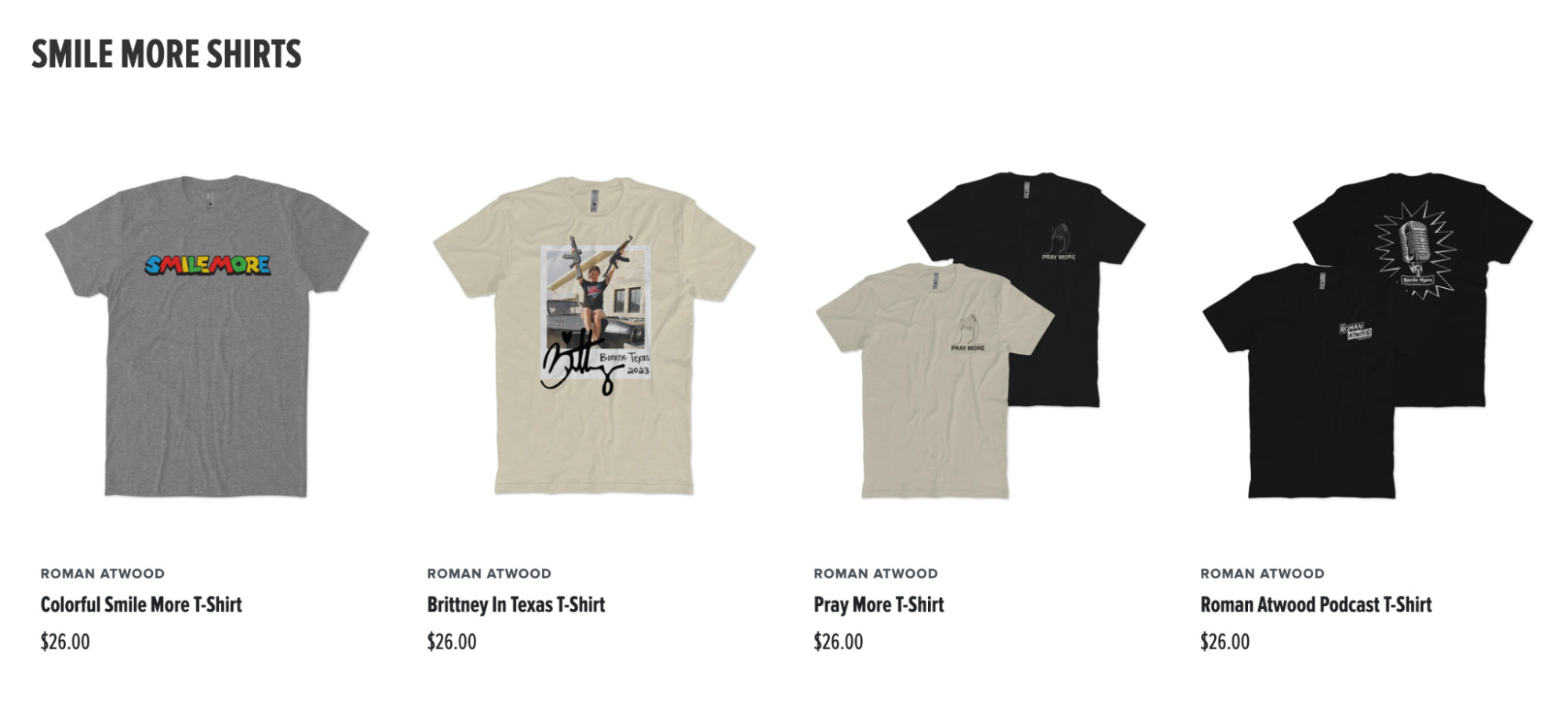 T-shirts displayed on an ecommerce website category page, showcasing potential merchandise for YouTube creators
T-shirts displayed on an ecommerce website category page, showcasing potential merchandise for YouTube creators
YouTube Shopping offers seamless ways for creators to sell merchandise directly to their fans from within their content. You can leverage YouTube Shopping to:
- Establish a Storefront on Your Channel: Create a dedicated shop tab directly on your YouTube channel homepage.
- Connect Your Online Store: Link your existing online store (e.g., Shopify store) to your YouTube channel to display your product listings around your videos.
- Tag Products in Videos: Directly tag your own products or products from partner brands within your videos, making them shoppable as viewers watch.
YouTube internal data indicates that over 160,000 creators are already utilizing YouTube Shopping to sell on the platform, highlighting its growing popularity and effectiveness.
Many creators successfully promote merchandise such as branded apparel (t-shirts, hoodies), accessories (tote bags, hats), and other items that resonate with their audience. You can also recommend products from brands you review or collaborate with, creating a diverse product offering.
Selling branded merchandise is more accessible than ever. Consider utilizing print-on-demand services to create affordable, custom products that are produced and shipped only when an order is placed, minimizing upfront costs and inventory management.
Setting Up Your YouTube Shopping Storefront
The simplest way to integrate YouTube Shopping is by connecting your Shopify store to your YouTube channel. This integration automatically synchronizes your product listings, ensuring your product catalog is consistently updated on YouTube. Customers can then complete purchases directly on YouTube or seamlessly navigate to your online store for a more comprehensive shopping experience.
If you don’t currently have an online store, platforms like Shopify offer easy-to-use tools to get started. You can even begin with a free trial to explore the possibilities.
4. Partnering with Brands as a YouTube Influencer
Brands are increasingly allocating marketing budgets to influencer marketing and sponsorships, recognizing the value of reaching engaged audiences through trusted creators.
This trend presents a significant opportunity for YouTube creators to negotiate brand deals in exchange for featuring products or services to their viewers.
YouTube marketing expert and influencer Brendan Gahan recommends establishing a baseline rate for sponsored content by estimating your average video views and multiplying that number by $0.05 to $0.15 per view. This provides a starting point for negotiation.
Your potential earning power can vary based on factors like your target audience demographics, content quality, and the uniqueness and profitability of your niche. If your channel aligns strongly with a brand’s target market, you may be able to negotiate more favorable terms.
Transparency is paramount when creating brand-sponsored content. Authenticity builds trust with your audience. Only endorse products or services that you genuinely like and believe in to maintain credibility and long-term audience loyalty.
5. Licensing Your Viral Content to Media Outlets
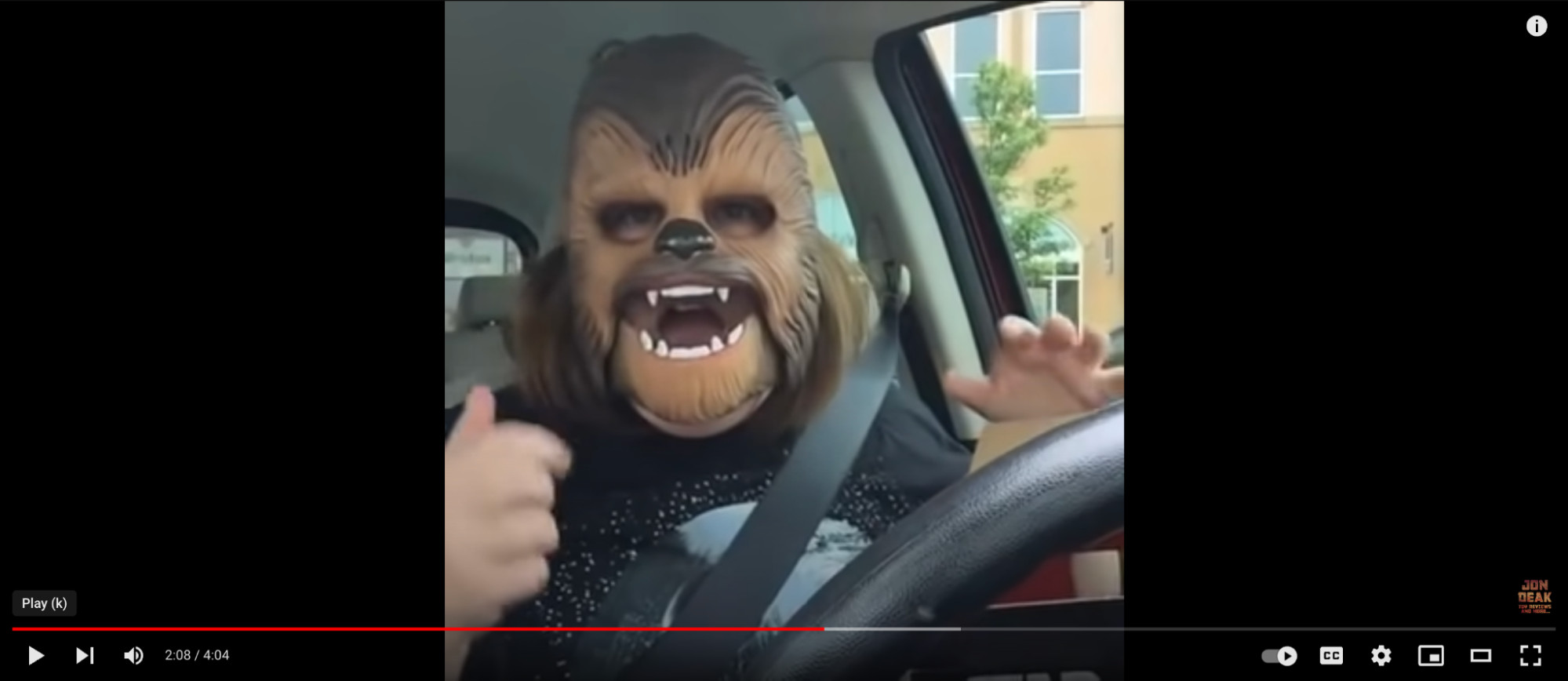 Screenshot of a YouTube video featuring a woman in a Chewbacca mask, example of viral content with licensing potential
Screenshot of a YouTube video featuring a woman in a Chewbacca mask, example of viral content with licensing potential
If you create a video that unexpectedly goes viral and gains widespread attention – perhaps a humorous clip, a heartwarming moment, or a unique event – you may have the opportunity to license your content to media outlets for a fee.
TV news programs, morning shows, online news websites, and other media platforms frequently seek to license viral videos to enhance their coverage.
You can proactively list your videos on content marketplaces like Jukin Licensing. These platforms connect content creators with media buyers, making it easier for your viral videos to be discovered and licensed by interested parties.
6. Crowdfunding Your Creative Projects with Your Audience
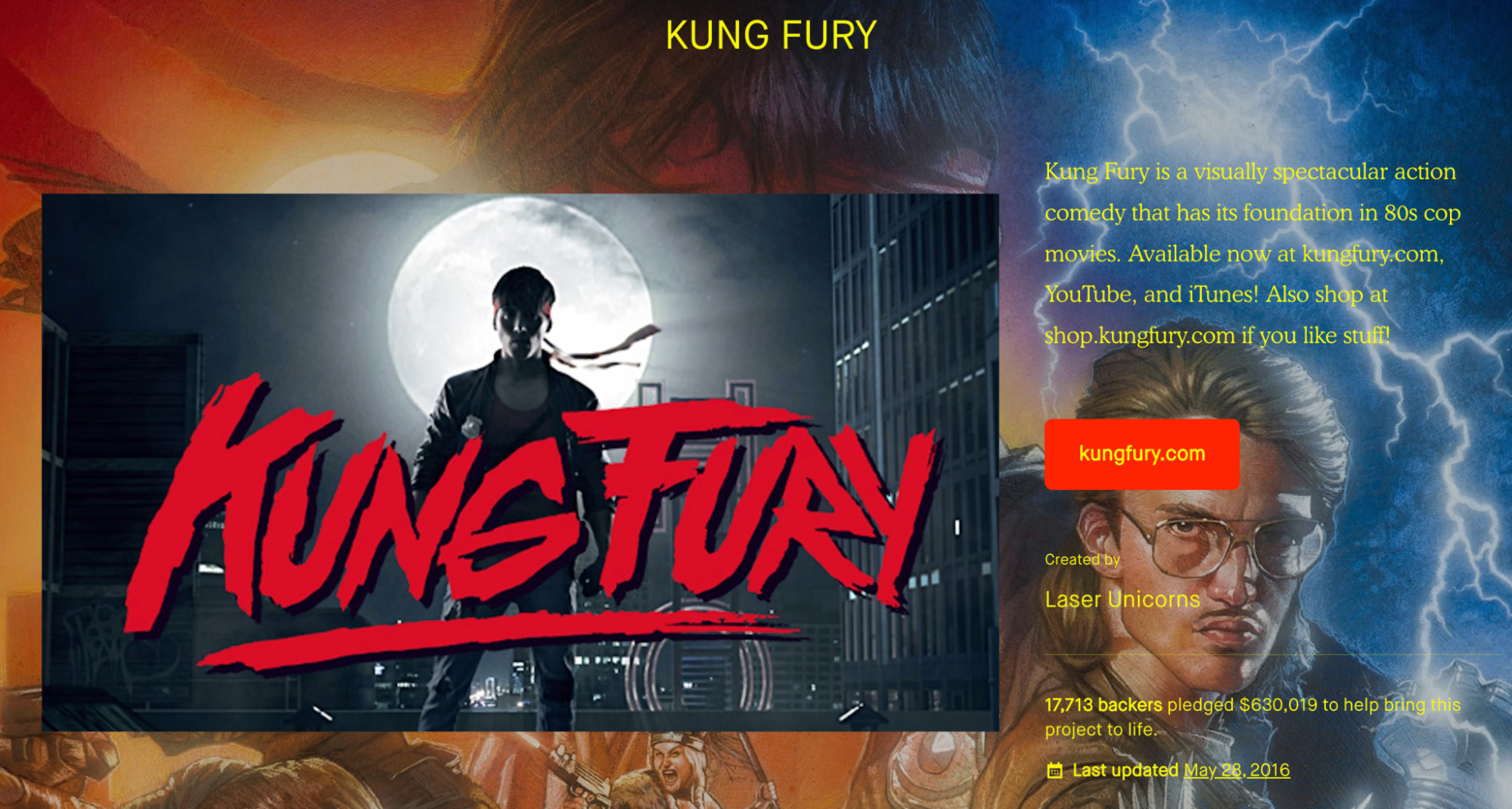 Kickstarter campaign page for Kung Fury movie featuring trailers and content, demonstrating crowdfunding for creative projects
Kickstarter campaign page for Kung Fury movie featuring trailers and content, demonstrating crowdfunding for creative projects
When funding becomes the primary obstacle to bringing a creative vision to life, crowdfunding presents a powerful solution. If you have an ambitious video project in mind – requiring new equipment, actors, travel, or other production expenses – you can appeal to your audience and community for financial support.
Many successful crowdfunding campaigns attract backers by offering compelling previews or trailers that generate excitement and demonstrate the potential of the project. Consider creating a video that clearly explains your project, showcases your vision, and offers a taste of what supporters can expect.
Popular crowdfunding platforms with a proven track record of success for YouTubers include Kickstarter and Indiegogo. These platforms provide the tools and reach to effectively solicit contributions from your audience and the wider online community.
7. Leveraging Affiliate Marketing to Earn Commissions
Affiliate marketing is a performance-based monetization strategy where you earn a commission by promoting products or services from other brands within your videos.
As a YouTube creator, you can become an affiliate marketer by creating content that naturally integrates product recommendations and promotions relevant to your viewers’ interests.
Getting Started with Affiliate Marketing
To begin affiliate marketing, research and identify affiliate programs that align with your channel’s niche and are likely to resonate with your audience. The more relevant the products or brands you promote, the higher your chances of affiliate marketing success.
Once you’ve joined relevant affiliate programs, you’ll receive unique affiliate links that track sales generated through your promotions. These links can be strategically placed in your video descriptions, end screens, or within info cards.
Affiliate marketing is particularly effective if your channel focuses on product reviews, tutorials, or lifestyle content where product recommendations are a natural fit. Brands often have low barriers to entry for affiliate programs, as they only pay commissions on actual sales, minimizing their risk. Always remember to clearly disclose your affiliate partnerships to maintain transparency and comply with advertising guidelines.
YouTube simplifies affiliate marketing through its Shopping affiliate program. This program helps you discover relevant products to promote and provides clear commission percentages. Once you find products you want to feature, tagging them directly within your videos becomes a streamlined process.
While any creator can include affiliate links in their YouTube content, accessing the official YouTube Shopping affiliate program requires YPP membership and meeting YouTube’s eligibility criteria.
Recruiting Affiliates for Your Own Products
Conversely, if you are a creator with your own product line, consider establishing your own affiliate program and recruiting other YouTubers to promote your products.
Eligible Shopify merchants can easily integrate their product catalogs into the YouTube Shopping affiliate program. This allows other creators to discover and feature your products in their videos, expanding your reach and sales potential. You can manage your affiliate program and set commission rates through the Shopify YouTube app.
Understanding YouTube Earnings: Key Metrics and Averages
Views and Revenue: What’s the Connection?
It’s a common misconception that a high view count directly translates to high revenue. While views are important for overall channel growth, the number of views alone doesn’t directly correlate to earnings.
According to data from Influencer Marketing Hub, the average YouTube channel earns approximately $0.018 per view, translating to around $18 per 1,000 views. However, this is just an average, and actual earnings can vary widely.
The critical factor determining ad revenue is ad engagement. For you to earn money from ads, viewers must either click on an ad or watch the video ad in its entirety (which can be 10, 15, or 30 seconds long, depending on the ad format). If viewers skip ads or don’t engage with them, even videos with thousands of views may generate minimal ad revenue.
Average YouTube Creator Earnings
While top-tier YouTubers like MrBeast can generate tens of millions of dollars annually, it’s important to remember that these are exceptional cases. However, creators with smaller, dedicated audiences can still build sustainable incomes on YouTube.
Consider Justine Leconte, whose fashion and style advice channel boasts over one million subscribers. Based on estimated ad revenue alone, her channel’s annual earnings are estimated to be around $259,304, with an average of $979 per video, according to Influencer Marketing Hub’s YouTube Money Calculator.
These figures suggest that even with a focused niche and consistent content creation, YouTubers can potentially earn a living by posting one or two videos per week. It’s crucial to recognize that these are estimates, and actual earnings can fluctuate based on various factors, including monetization strategies, audience engagement, and niche profitability.
Maximizing YouTube Revenue Potential
YouTube monetization isn’t solely dependent on subscriber counts. Your earning potential is significantly influenced by audience engagement, the specific niche you serve, and the diversity of revenue streams you explore.
While lists of top YouTube earners might create the impression that income primarily comes directly from YouTube ad revenue, the reality is often more nuanced. Many of the highest-earning channels have diversified their income through merchandise lines, brand partnerships, and other ventures. Building a loyal audience is the foundational step. Once you have an engaged community, exploring diverse monetization methods becomes significantly more effective.
Tips for Effectively Selling and Promoting on YouTube
Many YouTube monetization strategies involve promoting products or services, whether your own or those of partners. However, it’s crucial to integrate promotions authentically to maintain audience trust and engagement.
The perception of “selling out” is a legitimate concern for many creators. Conversely, neglecting monetization opportunities entirely can limit your ability to sustain your channel and creative endeavors.
Here are some tips for effectively integrating promotional content without alienating your audience:
Deeply Understand Your YouTube Audience
Building a strong and engaged audience is the cornerstone of successful monetization. To maximize your monetization potential, you need a deep understanding of your audience demographics, interests, and viewing habits.
For niche channels, audience insights are particularly valuable for attracting targeted brand partnerships. Pay close attention to:
- Audience Gender: Identify if your audience skews towards a specific gender demographic.
- Age Range: Determine the primary age groups within your audience.
- Geographic Location: Pinpoint the countries and regions where your videos are most watched.
- Audience Engagement (Watch Time): Analyze audience retention and watch time metrics to understand what content resonates most effectively.
This demographic data, readily available in YouTube Analytics, empowers you to refine your content strategy, tailor your promotions, and attract relevant brand collaborations.
Strategic Use of YouTube Info Cards
Whether you’re fulfilling brand sponsorship obligations or promoting your own products, info cards (formerly YouTube Cards) offer an effective way to capture viewers’ attention at key moments within your videos.
Utilize free video editing software to seamlessly integrate info cards at relevant points in your content. Time your cards to appear when they are most contextually relevant and least disruptive to the viewing experience, maximizing their impact and click-through rates.
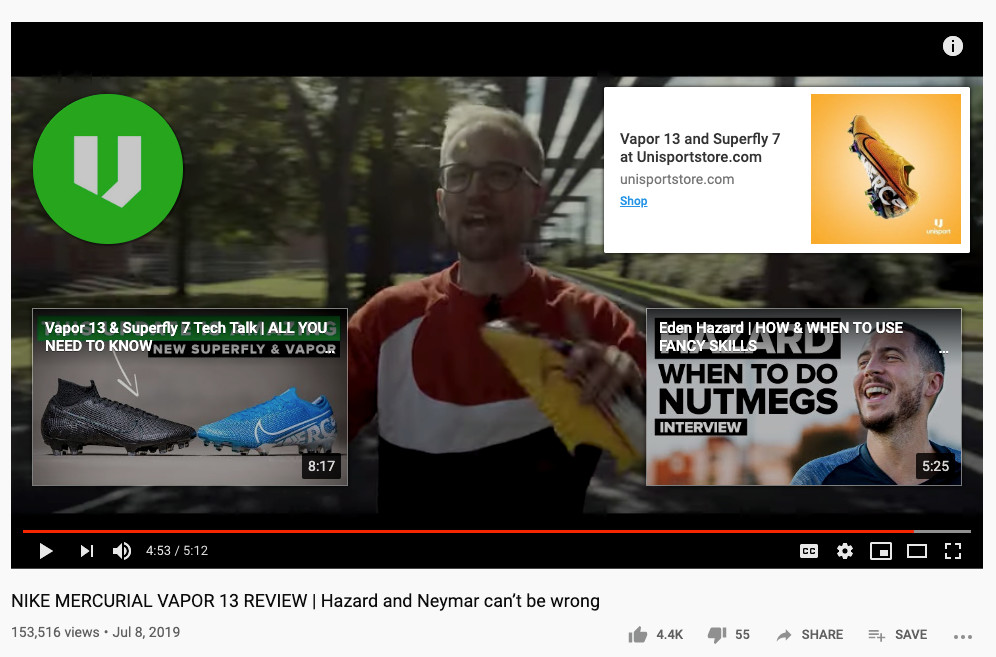 YouTube video showcasing info cards and an ad for shoes, illustrating promotional tools within YouTube
YouTube video showcasing info cards and an ad for shoes, illustrating promotional tools within YouTube
Leverage Video Descriptions for Links
Your video descriptions provide valuable real estate for directing viewers to external links. Use this space to link to your online store, Patreon page, crowdfunding campaigns, affiliate product links, or any other revenue-generating platforms.
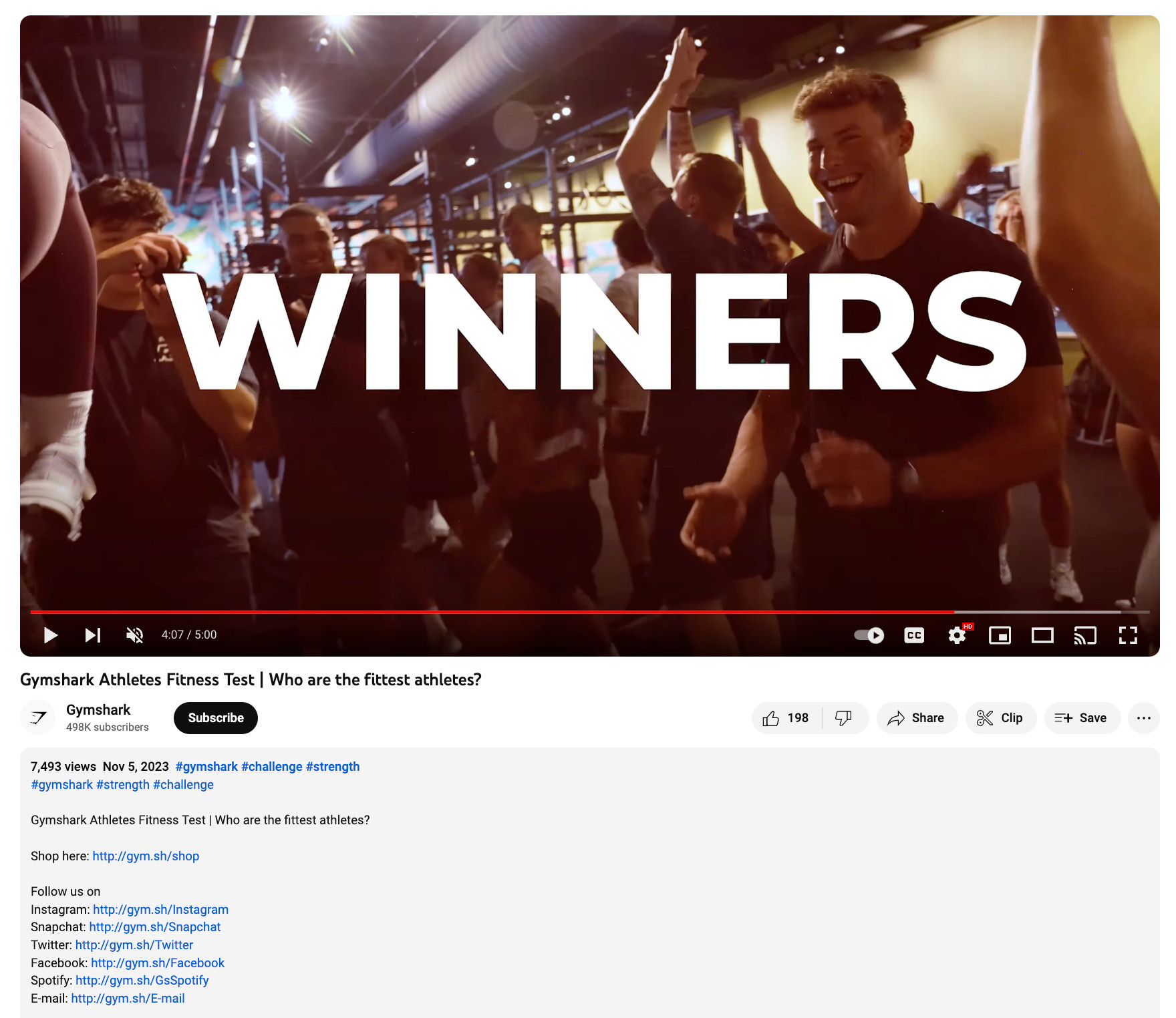 Gymshark YouTube video description with links to social media, demonstrating link placement for external platforms
Gymshark YouTube video description with links to social media, demonstrating link placement for external platforms
Promote Your YouTube Offers Across Platforms
Don’t limit your promotional efforts to YouTube alone. Amplify your reach by cross-promoting your YouTube channel, new video releases, campaigns, or discounts across all your other online platforms.
Share updates and promotional messages on X (formerly Twitter), Facebook, Instagram, and any other social media profiles you maintain.
The broader your promotional reach, the greater the likelihood of attracting new viewers and driving engagement with your monetization efforts. Building a strong presence beyond YouTube through social media marketing is a crucial element of long-term YouTube success.
The Enduring Power of the Creator Economy
For most creators, passion, not pure profit, is the primary driving force. However, with a well-defined monetization strategy, creators can transform their passion into a sustainable career and reap the rewards of their dedication, hard work, and continuous experimentation within the dynamic YouTube landscape.
The journey of creators like MrBeast, who started creating videos at age 13 and dedicated years to refining his content and understanding the YouTube algorithm, exemplifies the potential for long-term success and significant financial rewards.
Growing and maintaining an engaged audience is a fundamental challenge for businesses across industries. YouTube creators have already mastered this crucial element. By leveraging the strategies outlined in this guide, you can effectively monetize your YouTube channel and build a thriving online business.
How to Make Money on YouTube: Frequently Asked Questions
How many views are needed to make money on YouTube?
The number of views is not the direct determinant of YouTube earnings. Revenue is generated when viewers engage with ads by clicking them or watching them in full. Videos with thousands of views may not generate revenue if viewers skip ads or do not interact with them.
How much revenue can you earn per 1,000 views on YouTube?
On average, YouTube channels earn approximately $18 per 1,000 views. However, this is an estimated average, and actual earnings can vary depending on ad engagement rates, audience demographics, and video content.
Does YouTube pay for simply uploading videos?
YouTube does not directly pay content creators for uploading videos. To monetize content, creators must enable monetization features in their YouTube account settings and become part of the YouTube Partner Program.
What are the primary ways YouTubers make money?
YouTubers utilize diverse monetization strategies, including:
- Joining the YouTube Partner Program and earning ad revenue.
- Selling merchandise and products through YouTube Shopping.
- Utilizing crowdfunding platforms for creative projects.
- Leveraging fan funding through Super Chat, Super Thanks, and channel memberships.
- Licensing viral content to media outlets.
- Collaborating with brands as influencers for sponsored content.
- Participating in affiliate marketing programs to earn commissions.
Is it possible to make money on YouTube without creating videos?
Yes, you can indirectly profit from YouTube without creating your own videos by partnering with established creators to promote your products or services to their audience. The YouTube Shopping affiliate program allows Shopify users to add their products, enabling creators to tag these products in their videos for viewers to purchase.
